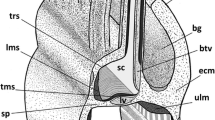Summary
Electron microscopy of the subradular organ of the chiton Lepidochitona cinereus (L) reveals at least three cell types, microvillous, ciliated and mucus-secreting, situated in a single epithelium. The base of the epithelium is abundantly innervated and supplied with muscle cells. The fine structure is consistent with a chemosensory function for the subradular organ.
Similar content being viewed by others
References
Bailey, D. F., Laverack, M. S.: Aspects of the neurophysiology of Buccinum undatum L. (Gastropoda). 1. Central responses to stimulation of the osphradium. J. exp. Biol. 44, 131–148 (1966)
Barnawell, E. B.: The carnivorous habit among the Polyplacophora. Veliger 2, 85–88 (1960)
Benjamin, P. R., Peat, A.: On the structure of the pulmonate osphradium. Z. Zellforsch. 118, 168–189 (1971)
Bullock, T. H., Horridge, G. A.: Structure and function in the nervous system of invertebrates. San Francisco and London: Freeman 1965
Charles, G. H.: Sense organs (less Cephalopods). In: Wilbur, K. M., and Yonge, C. M., Physiology of the mollusca, vol. 2, p. 455–521. New York and London: Academic Press 1966
Cloney, R. A., Florey, E.: Ultrastructure of cephalopod chromatophore organs. Z. Zellforsch. 89, 250–280 (1968)
Crisp, M.: Structure and abundance of receptors of the unspecialized external epithelium of Nassarius reticulatus (Gastropoda, Prosobranchia). J. mar. biol. Ass., U.K. 51, 865–890 (1971)
Feder, H. M.: Escape responses in marine invertebrates. Sci. Amer. 227, 92–100 (1972)
Heath, H.: The function of the chiton subradular organ. Anat. Anz. 23, 92–95 (1904)
Laverack, M. S.: On the receptors of marine invertebrates. Oceanogr. Mar. Biol. Ann. Rev. 6, 249–324 (1968)
Plate, L.: Die Anatomie und Phylogenie der Chitonen. Zool. Jahrb., Suppl. Heft 4, 1–243 (1897)
Plate, L.: Die Anatomie und Phylogenie der Chitonen. Zool. Jahrb., Suppl.-Heft 5, 15–216 (1899)
Purchon, R. D.: The biology of the mollusca. New York and London: Pergamon Press 1968
Stinnakre, J., Tauc, L.: Central neuronal responses to the activation of osmoreceptors in the osphradium of Aplysia. J. exp. Biol. 51, 347–361 (1969)
Townsend, C. R.: The food-finding orientation mechanism of Biomphalaria glabrata (Say). Anim. Behav. 21, 544–548 (1973a)
Townsend, C. R.: The role of the osphradium in chemoreception by the snail Biomphalaria glabrata (Say). Anim. Behav. 21, 549–556 (1973b)
Wells, M. J., Buckley, S. K. L.: Snails and Trails. Anim. Behav. 20, 345–355 (1972)
Welsch, V., Storch, V.: Über das Osphradium der prosobranchen Schnecken Buccinum undatum L. und Neptunea antiqua (L.). Z. Zellforsch. 95, 317–330 (1969)
Author information
Authors and Affiliations
Additional information
I would like to thank Mr. A. Morison for technical assistance with the electron microscopy, and Dr. W. J. Cruickshank for reading the manuscript.
Rights and permissions
About this article
Cite this article
Boyle, P.R. Fine structure of the subradular Organ of Lepidochitona cinereus (L), (Mollusca, Polyplacophora). Cell Tissue Res. 162, 411–417 (1975). https://doi.org/10.1007/BF00220187
Received:
Issue Date:
DOI: https://doi.org/10.1007/BF00220187




